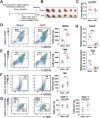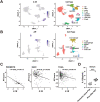IL-1β Is an Androgen-Responsive Target in Macrophages for Immunotherapy of Prostate Cancer
- PMID: 37092583
- PMCID: PMC10265092
- DOI: 10.1002/advs.202206889
IL-1β Is an Androgen-Responsive Target in Macrophages for Immunotherapy of Prostate Cancer
Abstract
Great attention is paid to the role of androgen receptor (AR) as a central transcriptional factor in driving the growth of prostate cancer (PCa) epithelial cells. However, the understanding of the role of androgen in PCa-infiltrated immune cells and the impact of androgen deprivation therapy (ADT), the first-line treatment for advanced PCa, on the PCa immune microenvironment remains limited. On the other hand, immune checkpoint blockade has revolutionized the treatment of certain cancer types, but fails to achieve any benefit in advanced PCa, due to an immune suppressive environment. In this study, it is reported that AR signaling pathway is evidently activated in tumor-associated macrophages (TAMs) of PCa both in mice and humans. AR acts as a transcriptional repressor for IL1B in TAMs. ADT releases the restraint of AR on IL1B and therefore leads to an excessive expression and secretion of IL-1β in TAMs. IL-1β induces myeloid-derived suppressor cells (MDSCs) accumulation that inhibits the activation of cytotoxic T cells, leading to the immune suppressive microenvironment. Critically, anti-IL-1β antibody coupled with ADT and the immune checkpoint inhibitor anti-PD-1 antibody exerts a stronger anticancer effect on PCa following castration. Together, IL-1β is an important androgen-responsive immunotherapeutic target for advanced PCa.
Keywords: IL-1β; androgen deprivation therapy; androgen receptor; immune therapy; prostate cancer; tumor-associated macrophage.
© 2023 The Authors. Advanced Science published by Wiley-VCH GmbH.
Conflict of interest statement
The authors declare no conflict of interest.
Figures







References
Publication types
MeSH terms
Substances
Grants and funding
- NSFC32022021/National Natural Science Foundation of China
- NSFC81972404/National Natural Science Foundation of China
- 21TQ1400225/Shanghai Pilot Program for Basic Research-Shanghai Jiao Tong University
- 21XD1422300/Program of Shanghai Academic/Technology Research Leader
- 20181706/Shanghai Municipal Education Commission-Gaofeng Clinical Medicine Grant Support
- Innovative research team of high-level local universities in Shanghai
- 2022YFA1302704/National Key R&D Program of China
- B21024/111 project
- 20JC1417600/Science and Technology Commission of Shanghai Municipality
- 21JC1404100/Science and Technology Commission of Shanghai Municipality
- Peak Disciplines (Type VI) of Institutes of Higher Learning in Shanghai
- Shanghai Jiao Tong University STAR and Scientific and Technological Innovation Funds
- KC Wong foundation
- 23YF1443300/Shanghai Sailing Program
- SB23-14/Shuobo Seed Program
LinkOut - more resources
Full Text Sources
Other Literature Sources
Medical
Molecular Biology Databases
Research Materials
